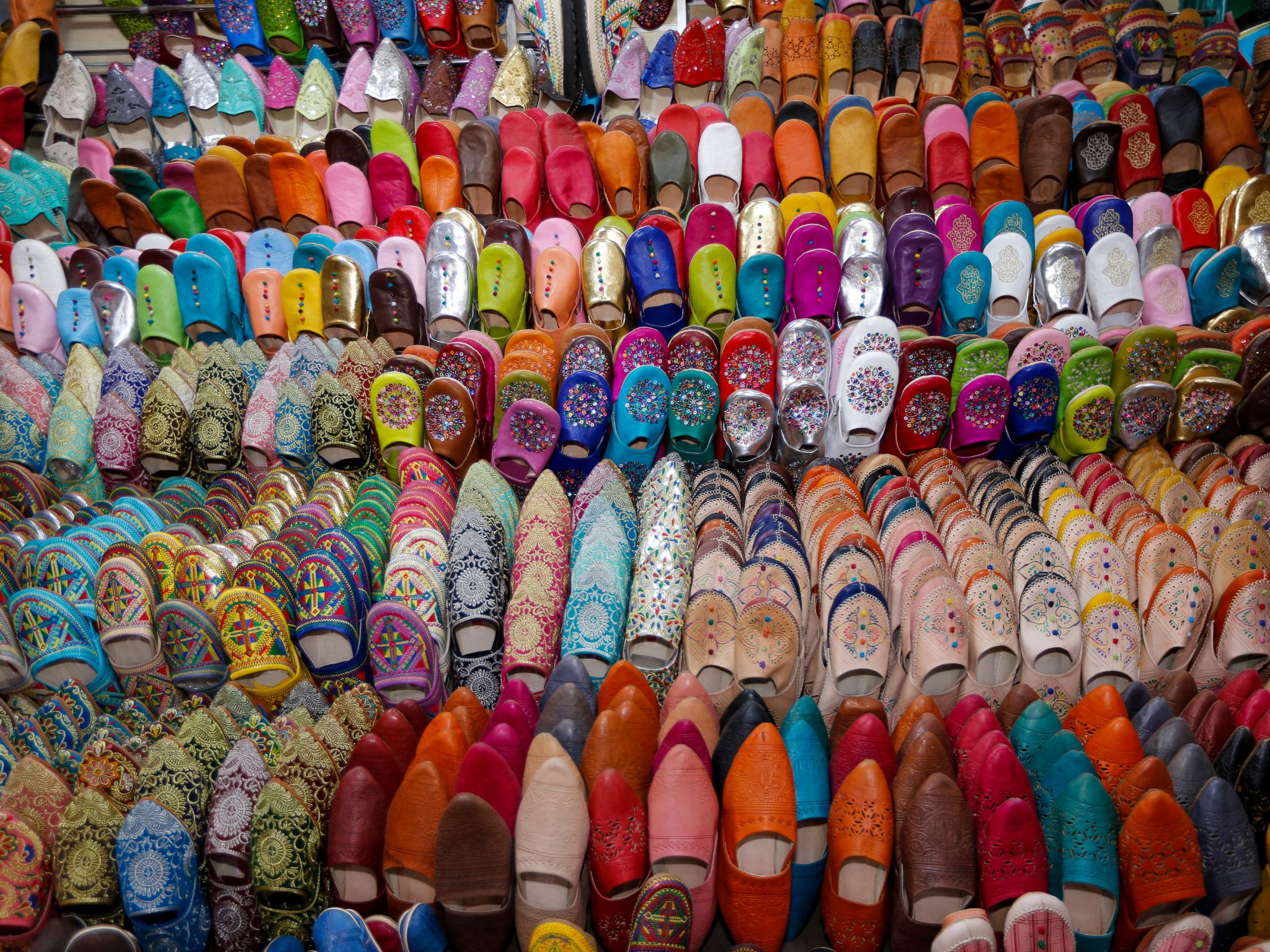Morocco is a very diverse country when it comes to culture, landscapes, climate and temperatures so it is important to pack accordingly, especially in the transition months of spring and autumn when temperatures can vary a lot between day and night.
On our trip to Morocco, we spend time in the desert, the mountains, by the sea and in the inland cities of Fez and Marrakech. It is not unusual to experience four seasons in a day with winter temperatures at night in Chefchaouen and hot days in the Sahara.
Additionally, it is common to spend hours in cars and buses traversing the expansive country so comfortable clothes you can sit on for extended periods of time are a must.
Bearing all this in mind, we put together this packing list for Morocco thinking specifically about the spring and autumn months and about a trip that explores most of the country.
To skip right to our packing list and tips, click here, otherwise keep reading for everything you’ll need to know about the weather during your stay in Morocco.
What to expect in spring and autumn in Morocco
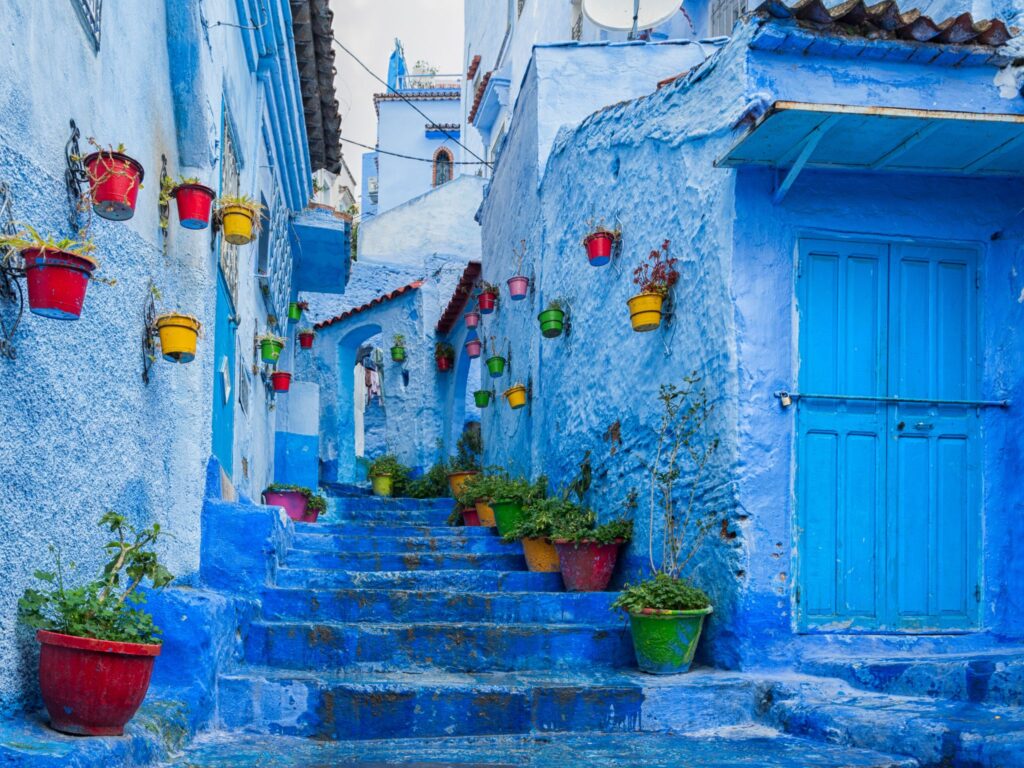
In general, autumn and spring are transitions periods in Morocco and agreed to be the best months to visit for the milder temperatures across the country.
The days are warm but not scorching hot like in the summertime, and the nights are cool but do not reach freezing temperatures like in some parts of the country during winter.
However, the diversity of eco-systems and landscapes in Morocco means that temperatures and climate can vary a lot from the coastal areas to the mountains and from the desert to the sea.
On average, May and October see temperatures between 15 and 25 C (60 to 77 F), and about 8-10 hours of sunshine per day.
This average changes a lot from the coastal cities of Casablanca and Essaouira where maximum temperatures do not surpass the 20 C (75 F) and the interior cities of Marrakech, Fez where maximum temperatures already reach 30 C (85 F).
In contrast, the mountainous areas see much lower temperatures. In Ifrane, May and October see temperatures between 6 and 18 C (45 and 65 F). The Sahara desert experiences high temperatures close to 30 C during the day that drop to 5-10 C at night.
The weather in Morocco in May
May is a great time to visit Morocco. Rainfall is low and temperatures are warm during the day but have not yet reached the unpleasant levels of the summer. Below are the key facts for the cities we visit during our trip:
- Marrakech: Temperatures between 15-30 C (59-85 F) with 9.5 hours of sunshine a day and 6 days with rain.
- Essaouira: Temperatures between 14-10 C (57-68 F) with 10 hours of sunshine a day and 3 days with rain.
- Casablanca: Temperatures between 16-23 C (61-73 F) with 10 hours of sunshine a day and 6 days with rain.
- Ifrane: Temperatures between 6-18 C (43-64 F), with 9 hours of sunshine a day 6 days with rain.
- Fez: Temperatures between 12 and 26 C (53 and 78 F) with 9 hours of sunshine a day and 10 days with some rain.
- Chefchaouen: Temperatures between 15 and 20 C (59-68 F) with 8 hours of sunshine a day and 5 days with some rain.
Looking at the above, we know that temperatures will change a lot through the day and the trip as we approach mountains and descend into the desert and the sea. Therefore, packing in layers will be key to stay always appropriate to the weather.
Lastly, it is also important to note the humidity levels. While the coastal areas will experience high humidity, the desert and mountain parts will be much drier.
The weather in Morocco in October
The weather in October mirrors that of May both in terms of temperatures as well as sunshine and rainfall, with a small increase in the probably of rainfall across the country.
The weather is pleasant across the country with the highest temperatures experienced in Marrakech and the lowest in Ifrane and the Sahara at night.
Tips when packing for Morocco in autumn and spring
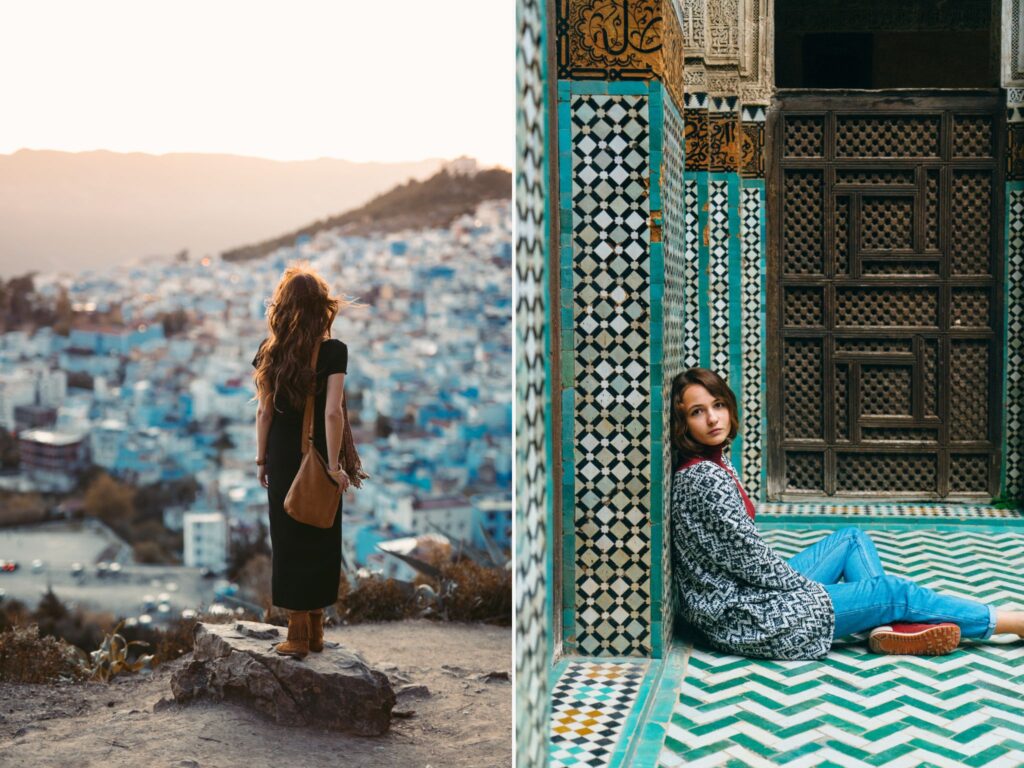
Considering the weather outlook explained above, it is important to pack accordingly to be comfortable and able to adapt to the changing daily temperatures.
This means, bringing enough layers to withstand a 10-20 degree change in temperatures in a day, the occasional risk of rain and the unwavering sunshine.
Note: Click here to see all our item recommendations in one place on our Amazon Storefront.
Pack light
I am not saying this lightly (pun intended) but you really want to pack light for this trip. We will be packing and unpacking a lot, moving every other day sometimes every day, and you don’t want to be lugging around a large and heavy suitcase.
Surfaces are uneven, riads have stairs and narrow corridors lined with lots of carpets, you really don’t want to make your life and that of the poor staff helping you, harder by bringing a large and heavy suitcase. Pack smart, bring only what you need and repeat outfits, nobody will think less of you.
As mentioned below, Morocco is a casual destination where comfort should trump style, so pack smartly and don’t bring several outfits per day, on most days there will be no occasion to dress up or get changed.
Footwear for the medinas
All the medinas we will be visiting are hundreds of years old and have remained almost untouched and preserved.
The narrow maze-like aisles of these old cities are uneven, sometimes wet, can be slippery, and are incredibly crowded at all times of the day with people, working animals such as donkeys and produce stacked and displayed everywhere.
This means comfortable, sturdy, closed-toe and nimble footwear is essential to navigate these ancient corridors and high heel shoes or open sandals such as flip flops are not recommended.
Layer up
I’ve said it already but the daily temperatures will change a lot through the day and through the trip. From winter in the mountains and desert nights in the Sahara, to full summer in Marrakech, planning your outfits in layers is a must.
Start with a base layer t-shirt or blouse, and top it off with a sweater, cardigan, or light jacket and a scarf for the coldest days. You can leave the layers you will not need in the bus on the days when we are moving a lot, but better bring more than miss a layer and be cold.
Beware of pickpockets
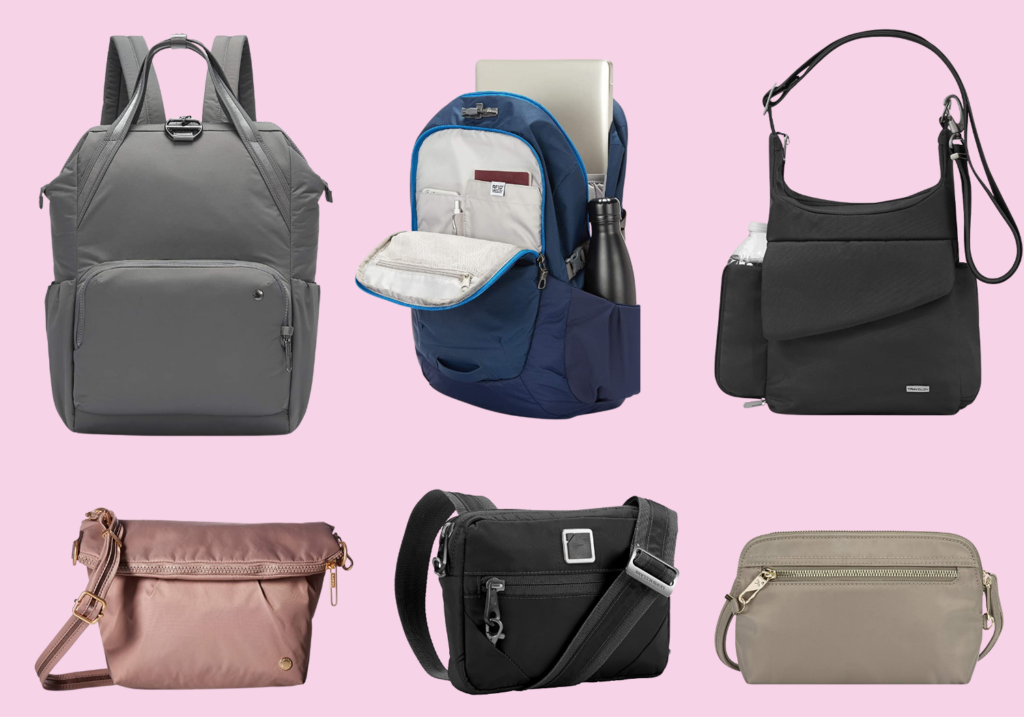
Morocco is a generally safe country when it comes to crime, although harassment is a commonly raised issue among women in particular.
The constant peddling in the markets and medinas and the crowds can be overwhelming even for the most well traveled, and it is almost impossible to spend a day in the main cities of Marrakech and Fez and not be approach by somebody who is trying to offer or sell something to you.
Although crime is low, distractions are many and pick pocketing a risk that is easy to avoid with an anti-theft bag. Stay always alert and keep your belongings safe with one the many bags that have been designed for these specific type of situations.
Slash-proof, anti-theft bags are designed for extra safety. Alternatively, a cross-body bag that is always zipped and in front of you should work.
There are so many easy targets available in crowded places that, as soon as you make yourself a more difficult one, you raise the barrier for the average thief. Below are some of the best anti-theft bags.
Be respectful to the local culture
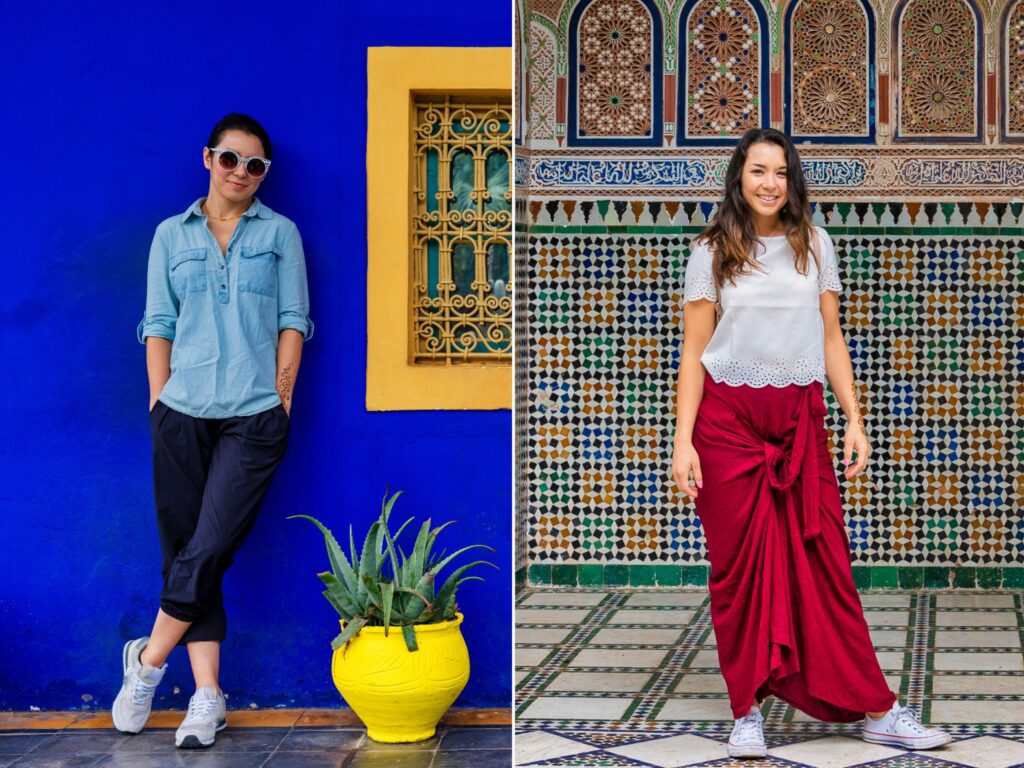
Morocco is a majority muslim country and locals dress conservatively.
We recommend following suit and opting for longer clothes than you may wear back home. This is not only useful to blend in, be respectful of local norms an always ready to enter any building, but also to protect from the very strong sun.
I don’t like having to lather on sunscreen all the time so long sleeves help protect my skin from the sun rays. If a dress, however long, has a cleavage, wearing a thin top underneath is a good idea.
During our trip, we will not be entering many mosques as the majority of them are reserved to muslims and used for prayer, but we will visit a couple where covering shoulders and knees is required.
Casual rules
Moroccan women, especially the younger city dwellers, like to dress up in the cities of Casablanca, Rabat and Marrakech and it is common to see them towering in high heels and beautiful outfits.
We will also enjoy a couple of fancier meals on the welcome and farewell evenings when cuter classier outfits will suit if you feel like dressing up.
However, the majority of a trip in Morocco will be spent out and about, walking the medinas and historical places and in casual surroundings where being comfortable is more important.
What to pack for Morocco in spring and autumn
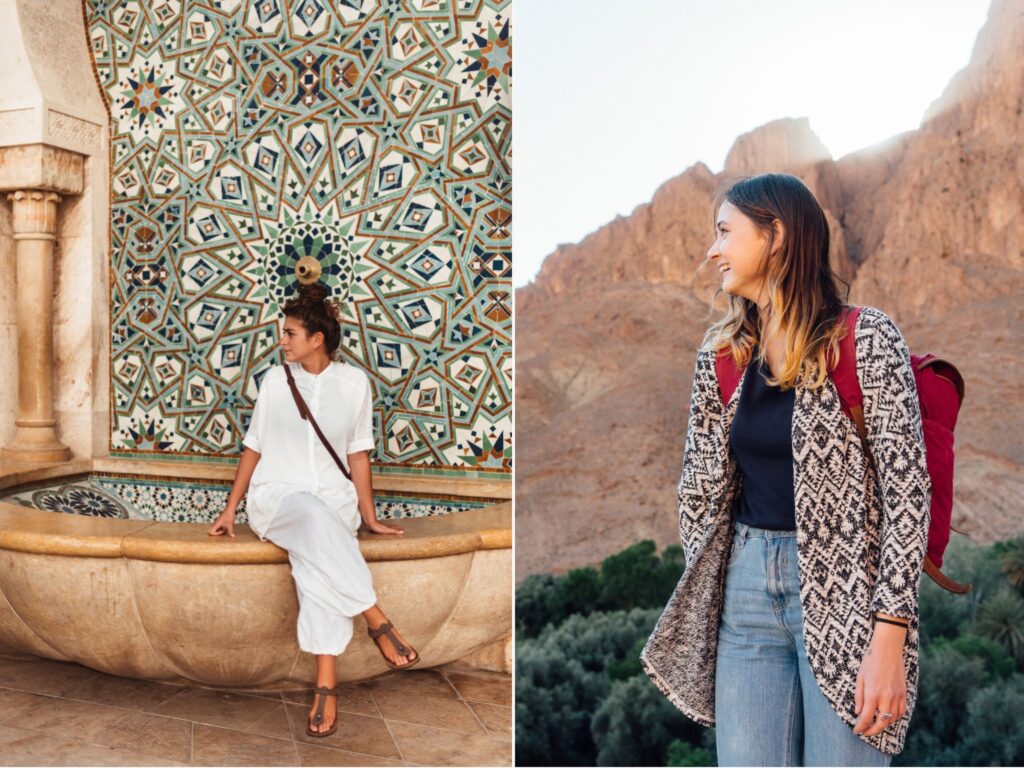
Now that you understand the weather and the local culture when it comes to dress code, let’s take a look at some items we recommend packing for a trip to Morocco.
Long dresses and skirts
Long dresses or skirts, or those that cover you below the knee, are useful and comfortable and can help you go from day to night when paired with a cardigan or jacket. They look sleek and can be very classy while remaining conservative.
When picking the right ones, remember to stay conservative and avoid spaghetti straps or strapless dresses and opt for short or long sleeve dresses and flowing, loose versions over tight ones.
Denim trousers
Denim jeans can be quite useful in the autumn and spring months in Morocco. They are versatile and sturdy, don’t need ironing, pair with anything and can easily work for day or night if accessorized properly.
I would however not recommend wearing them on the longer driving days as they may not be the most comfortable.
Tunic + leggings
Another great combo for Morocco that is also very commonly worn by the local women are leggings that are layered with a colorful tunic, or even a short dress or oversized shirt.
This is comfortable, adequate for the local culture and can be pretty fashionable. You will also see many tunics being sold at classy Moroccan fashion stores, especially in Casablanca and Marrakech.
Stretchy or loose pants
Remember when I said we would spend quite a lot of time in the bus? That’s right, we will be traversing the country and the only way to do that is on wheels.
Sitting down for long periods of time can be quite uncomfortable if you are wearing jeans or other restrictive trousers so a pair of stretchy or loose pants will come in handy. Even yoga pants/leggings are a good idea for these cases.
A light jacket
You already know the weather forecast and the temperature ranges so a jacket needs to be included in your packing list.
This does not need to be a winter jacket because it will only come in handy in the late evening or early mornings, and when we are in the mountains, so you may have to carry it around when the temperatures warm up.
While the weather fluctuates so much from Ifrane to Marrakech, this packable down jacket helps to keep you warm on those really cold days or nights, while this rain jacket will help keep you dry if it rains in Fez.
Otherwise, a fluffy fleece like this one or even a thick cardigan may be the best alternative. If you like it more stylish, a denim jacket can also work, though it’ll be heavier to carry around.
A scarf
Although we will not be entering too many religious buildings, it pays to have a scarf handy in case we get the opportunity to enter a place of worship.
A scarf can also come in handy in the plane, when they crank up the AC, or in the evenings when the temperatures drop, to complement a lighter jacket. It will also be useful to keep the dust away in the desert or the strong smell of the tanneries out.
A cute evening outfit
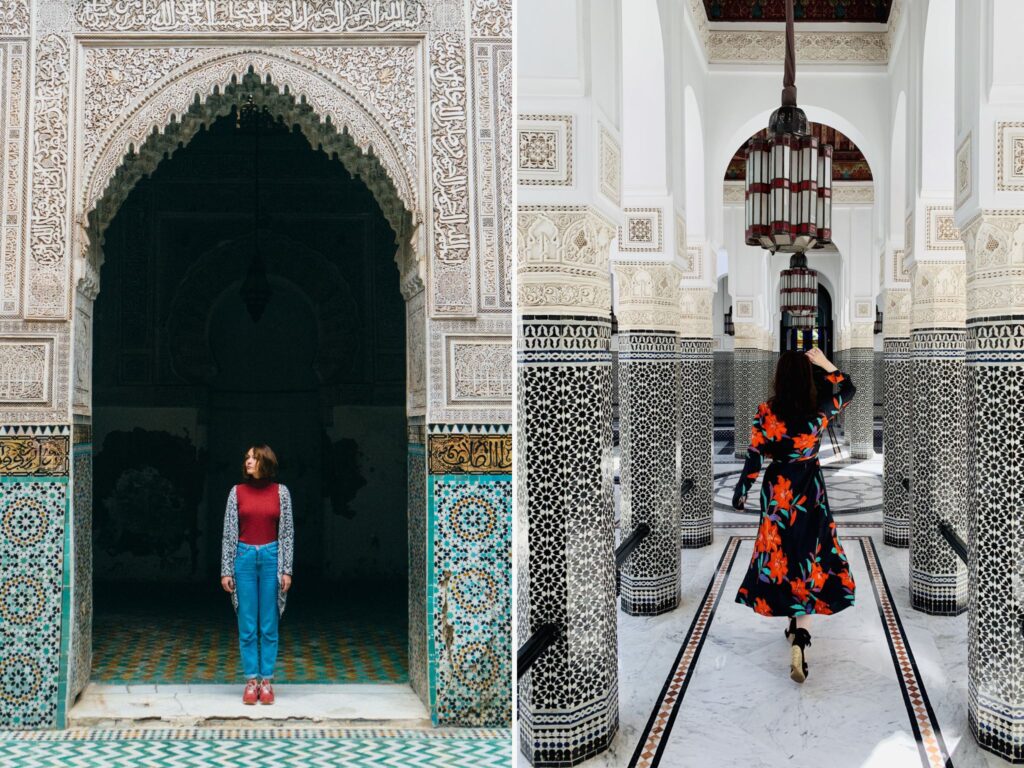
We always like to celebrate the start and end of our tours with a lovely dinner when a cute outfit will come in handy, so bring an outfit to celebrate with us.
This dress is a nice option you could dress up or down while staying modest. This one is also a great option. Like I said before, long skirts are also a versatile option to go from day to night. A pair of sandals like these would also be perfect.
Comfortable closed toe shoes
I mentioned it above, a pair of comfortable shoes is essential for all the walking in uneven surfaces and streets. Something that is sturdy, that you can be in for hours, and that has grip.
I added the recommendation for them to be closed-toe because, while sandals are very convenient in the warmer days, temperatures drop at night and the medinas tend to have dirty floors that can be wet or muddy.
For example, you can wear a pair of cute sneakers, walking ballerinas, etc. Here are a few options I wear or have seen our guests wear on our tours:
- Sketchers Bob’s cute sneakers are good for walking and comfortable, but not chunky.
- Classic Lacoste sneakers that can be preppy cute even with a dress.
- A pair of Converse always a classic.
- Super comfy pair of ballet flats.
- Superga, an all-time favorite pair of walking shoes, now in cute pastel colors.
- Birkenstock sandals that are made for walking.
- These Dr. Scholl’s sneakers are definitely our choice for class, versatility and comfort.
Other things to pack for Morocco
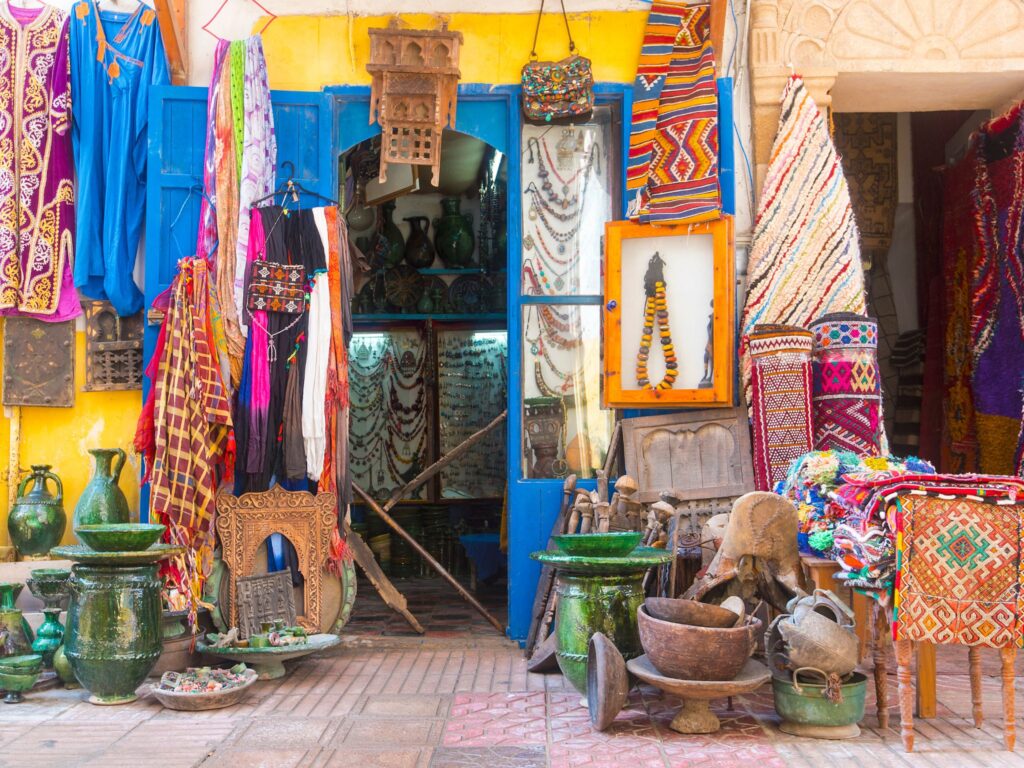
Besides clothing, there are a few other things worth packing for your trip to Morocco.
- Swim suit: Very important not to forget bringing your bikini or swimsuit as we will have the chance to enjoy the hotel’s pools in Casablanca if you arrive earlier, in Fez on the free afternoon and in Marrakech if you stay longer or your flight is later in the day. This microfibre towel is very helpful to bring while packing light.
- A sun hat or cap: As mentioned, the sun will be shining all day long so a hat is a great way to protect eyes and face from the sun exposure. Check out this wide brim one.
- A supportive bra: We will spend a lot of hours in bumpy roads, a good bra to keep it all in place is a good idea.
- A travel umbrella: We will be spending a lot of time outdoors and if showers appear, a travel umbrella will come in handy. This one weighs less than 500 gr. And is wind-resistant. Ponchos scream tourist.
- Universal plug adaptor: Morocco uses standard two prong round European plugs. We like the ones which come with USB ports so that we can charge phones, cameras and everything else with just one adaptor. I love this one because it has USB ports for all the electronics we now carry.
- Power bank: Because the days will be long and we will spend many hours in the car, making several stops along the way, a power bank will ensure you can continue taking photos. The INIU Portable Charger has a 20000mAh capacity, and fast-charging USB-C ports, you can power up your devices in a flash, while the LED display keeps you in the know about your battery level.
- Sunglasses: We expect sunshine galore so a pair of sunglasses is an essential travel item. I like and wear Oakley sunglasses as they are polarized and protect your eyes from any damaging sun rays. I alway wear them. Yes, they are not fashionable, but I have sensitive eyes that don’t like bright days, so they are a lifesaver for me.
- Water bottle: Single use plastic bottles are terrible for the environment so we recommend you bring your own reusable bottle as part of our efforts towards zero-waste and responsible travel. Tap water will not always be safe to drink but you can replenish your bottle at breakfast.
- Sunscreen: Perhaps the most important item in this packing list is sunscreen. Living in the tropics, this is an everyday item for me I never leave the house without. This one has amazing reviews on Amazon.
- Lip balm: The sun and dryness of the desert makes it particularly tough for the skin and lips so you should bring a lip balm to stay moisturized. We find these are essential to not end up with completely ruined lips or even blisters. This Nivea one comes in a pack of 4 and has SPF, so your lips will never be dry again!
- Sleep mask: Although hotels have proper blinds, you will be sharing the room with another traveler who may be a late owl. Bring a sleep mask like this one to block the light.
- Pajamas: As mentioned, you will most likely be sharing a room so don’t forget to pack your pajamas! Meg has these ones.
- Ear plugs: It is never a bad idea to have a pair of earplugs handy, for the flight, a noisy neighbor or an antsy roommate.
- First aid kit and medication: Available medications, brands and products in Morocco may not be the same as back home, so it’s always best to bring everything you are used to and of course, all prescription medication or vitamins you take. We also recommend packing a basic first aid kit with items such as plasters, an antiseptic ointment, eye drops, hydration powder, etc. We’ll spend time in a car on extremely windy roads so motion sickness medication is a good idea if you are prone to getting it. Have a look at our suggested first aid kit here.
- A pair of flip flops: These are not to be worn outside, but at the hotel when you go to the pool and walk around for breakfast. I have been wearing Havaianas for decades and like these silver skinny ones.
- Tissue paper: Many toilets on our road trip part may not have it so it’s always best to bring your own. This portable pack is great to bring on-the-go.
- Sanitary products: Morocco may not have the product or brand you like to use, may not stock things like tampons, or we may not be near an urban center where larger supermarkets are available, so it’s best to bring your own with enough amount for the duration of the trip.
What not to pack for Morocco
There are also a few things we do not recommend you bring to Morocco, mainly, because you won’t need them.
- Revealing clothes: This goes for short shorts, miniskirts, mini dresses, tops which show a cleavage, tank tops, crop tops, etc. all these you are best to leave at home.
- Hair dryer: Most hotels have them and if yours is old, you’ll also need to carry a converter or make sure it works with double voltage so that it does not get fried by the 220V.
- Hand bags that don’t close: You know the ones, the basket-style ones that don’t have a zipper to close them are a big no-no in the crowded medinas, unless you want to make pickpockets happy.

